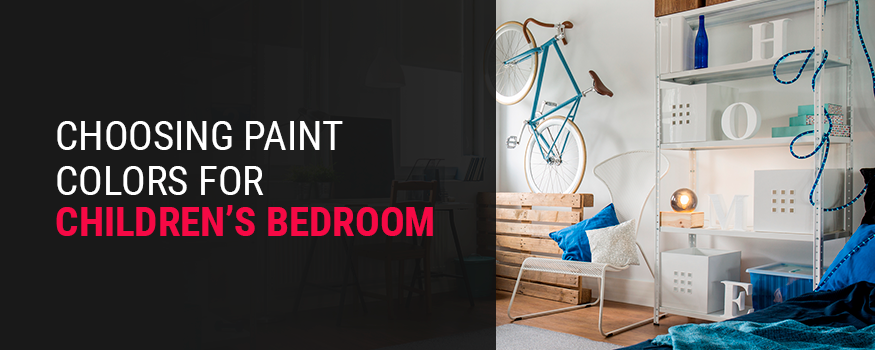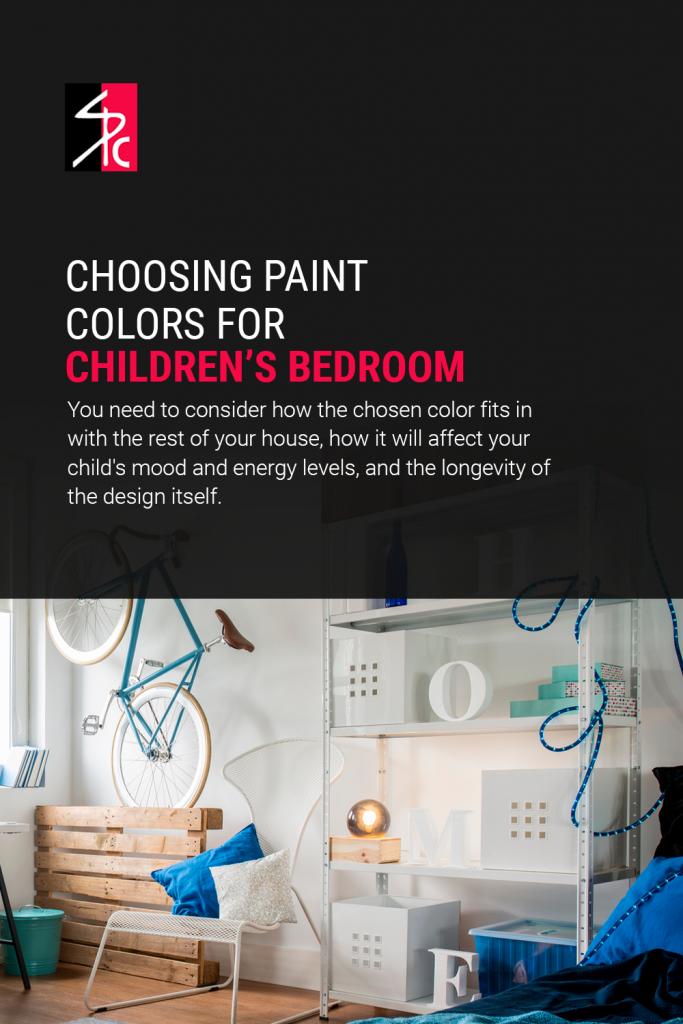Choosing Paint Colors for Children’s Bedrooms
December 7, 2021

The first step in designing any child’s room is choosing the paint color. The color of the walls will set the mood for the rest of the room, and unlike throw rugs or furniture, it can’t be easily changed. That’s why it’s essential to think long and hard before you commit to a color for your child’s room.
Many factors can play into this decision. You need to consider how the chosen color fits in with the rest of your house, how it will affect your child’s mood and energy levels, and the longevity of the design itself. You may want to consult a professional such as Shoreline Painting and get their opinion.

Consider the Rest of the House
One important thing to consider before selecting a color for your child’s room is the interior style of your house. A child’s room can fit their tastes and personality perfectly but clash with the flow of your interior design. In these cases, you can try a few things to make sure you and your child are satisfied:
- Shade: Even if the color your child wants isn’t used anywhere else in your house, it’s possible to change the shade so that it works with your interior design. For example, say your child has their heart set on a blue room. If your home’s paint color scheme is mostly warm colors in soft, muted shades, using a softer, muted shade of blue instead of something more vibrant can help the blue harmonize with the colors in the rest of the house.
- Furniture: To further coordinate your child’s room to your interior design, try to match their wall colors with common furniture colors in your house to keep a common design thread throughout.
- Compromise: If you can’t change the tone of the color, try incorporating it in a way where it won’t stick out. Consider using it as an accent against a more neutral tone or only having one wall painted in that color while the others are painted in another color that fits better with your interior design. Painting only one wall has the added benefit of being easy to replace if your child grows out of that color.
- Unify with accents: Even if your home uses a wide variety of base colors, you can unify the design using matching accents. For example, consider having the window trim, door trim, and moldings throughout the house painted the same color.
If you’re unsure how to match your child’s room to the rest of your house, contact Shoreline Painting for a color consultation. Our professionals will determine the best paint colors for your kids’ rooms in relation to the rest of your house.
Consider the Mood
Another thing to consider when choosing room colors is how they will affect your child’s mood. Studies have shown that different colors can alter moods. Colors that have positive effects as accents can have negative effects if used in excess. Consider the pros and cons of each color carefully before committing to it as a base:
- Red: This extremely warm, vibrant and stimulating color can increase energy, heart rate and blood pressure. However, too much red can trigger feelings of aggression and being over-energized.
- Pink: This softer color is more calming than red, especially in pastel shades. However, overuse can lead to headaches and feelings of irritation.
- Orange: Orange is a warm and cheerful color and a middle ground between red and yellow.
- Brown: This warm but earthy tone can help the viewer feel grounded but can also make a room feel small and cramped in high doses.
- Yellow: The most upbeat of the warm colors, yellow can increase energy and improve concentration and memory. Too much yellow can lead to feelings of annoyance or anger.
- Green: Green is a vibrant cool color often associated with nature. Pastel greens can help soothe anxiousness, but darker shades may leave the room feeling cramped and dim.
- Blue: This calming cool color can lower blood pressure and slow the heart rate. However, in high doses, blue can have a depressing effect.
- Purple: This stimulating cool color can increase thoughtfulness and creativity. Overusing purple can lead to feelings of depression and low energy.
- Gray: This neutral color works well when accented with brighter tones. Too much gray can lead to feelings of loneliness, but it has longevity as a base color choice.
In general, a lighter shade will open up a room, while a darker shade will make the room feel smaller. If you aren’t sure what mood you want to create or how best to create it, contact Shoreline Painting for a color consultation.
Get Your Child’s Input
Since your child is the person who will be living and sleeping in their room, it might make sense initially for them to have the final say in what color it is. However, children often lack foresight, and their tastes can change rapidly, but this doesn’t mean you should cut them out of the color selection process entirely. You can include your children in color selection in several ways and still get a room that will make both of you happy.
- Choose specifics for them: A good way to compromise with your child is to let them pick the base color, then you choose the specific shade. Say your child has their heart set on a purple room. Instead of a neon shade, you can easily choose a light pastel that fits in with the rest of your interior design.
- Give them options: Another way to help your child feel involved is to pick several color options and let them choose one themselves. This way, they still feel like a participant, but you have control over the potential options.
- Just one wall: For a pop of color that will appease your child, consider having just one wall painted in their preferred shade. If you particularly dislike the color but can’t compromise, make it the door wall — this way, the color will be invisible from outside the room.
- Draw inspiration: If your child has a favorite character, game or story, try pulling room color ideas from that theme. This doesn’t necessarily require detailed art — even a few base colors can evoke that theme. And if you can make a connection between your preferred design and something they love, then you’ll both be happier for it.
Think About the Future
As children grow, their preferences change. What makes them happy now might not in a few years or even months, and having their room repainted every time they change their preferences isn’t efficient. Additionally, there are practical reasons not to go with extremely personalized designs — resale value. The idea of having to repaint rooms is often unappealing to potential buyers, so a timeless design can be appealing from the start and helpful in the long run.
Here are a few easy ways to keep your child’s room long-lasting:
- Neutral base colors: If the room’s painted in neutral tones, it’s easier to pair with pre-existing furniture or design preferences. Instead of bright colors, consider having the walls done in neutral tones like gray or beige. If you must go with a non-neutral color, use a lighter, muted shade that can pair well with most design themes. This also holds up well to growing children and changing preferences.
- Limit bright accents: If you decide to incorporate bright colors into your child’s room, consider doing it in small or easily changeable ways. Limit bright colors to accents, or paint a single wall in a bright color while leaving the rest a neutral tone. This way, if you decide to make any color changes, you’ll only need to have the accents or the single wall repainted.
- Look into popular themes: A simple way to design a long-lasting color scheme is to look into what colors are traditionally long-lasting. Trends can change from year to year, but some stay relatively popular over time.
If you’re unsure how to create a long-lasting design, consider calling Shoreline Painting for an at-home consultation.
Consult a Professional Painter
Even after doing your own research, committing to a child’s bedroom color might seem like a daunting task. In these cases, consider enlisting a professional painting consultant. Shoreline Painting offers color consultations to help you make the best choice for your child’s room. With the help of our professional consultants, you can make a confident, informed choice on what paint color to choose.
There are several reasons to bring in a professional painting consultant, aside from just the comfort of a professional opinion:
- Light evaluation: Paint colors often appear different depending on the lighting in a room. Our consultants can recommend optimal colors, depending on the amount of natural and artificial light the room gets.
- Pre-existing interior design: Our consultants can create a theme that looks good on its own and fits in with the existing interior design of your home.
- Mood: Our consultants can help you choose the perfect mood for your child’s room by selecting colors based on their effects on emotions and energy levels.
- Longevity: Our consultants are well-versed in current trends and popular color schemes. The guidance they provide will help you create a color scheme that lasts.
- Get involved: Our consultants will come to your home to assess the space you want painted. Once you explain your preferences and what mood you’d like the room to create, they’ll present several options so you can make the final decision. In the end, you still have full control.
Shoreline Painting is fully qualified to assess your living space and guide you towards your ideal paint color. We are a Fine Paints of Europe Certified Master Painter, skilled at envisioning and executing quality painting services that last. Our consultation process is as follows:
- Once you book your appointment, our color consultant will arrive at your specified location.
- The consultant will examine the space you want to have painted.
- Once they’ve assessed the area, they’ll discuss your style preferences and what kind of mood you want to create in the room.
- Finally, they’ll present you with various choices to select from.
Our goal is to ensure your satisfaction with the final product. Our consultant will work with you to ensure that you love the colors you choose.
Color Scheme Ideas for Children’s Rooms
Even after considering your child’s mood and preference, the rest of your home’s design, and a professional opinion, you may still be unsure how to design your child’s room. Here are a few color scheme concepts to help you get started.
Warm-Toned Themes
Warm tones can create feelings of warmth, energy and passion in a room. They include variations of red, orange and yellow. In general, warm colors work best as accent colors to more neutral shades, like brown and gray. Here are a few potential themes for your child’s room that use warm colors:
- Pink and white: Pink and white play off each other excellently when one is used as an accent. These colors work well with neutral or pastel-colored furniture and are a popular choice for girls’ rooms.
- Yellow and gray: The bright energy of yellow is a good contrast to the more somber energy of gray. Consider a lighter shade of gray for the walls with a yellow accent wall or smaller yellow accents throughout.
- Orange and brown: Light shades of both colors can create a warm, autumnal feeling in a room. Consider using white or gold accents for an elegant finish.
Cool-Toned Themes
Cool tones can create feelings of peace and calm in a room. They include variations of green, blue and purple. Cool colors often work better as base colors than warm colors do, so long as their shade isn’t too bright. Here are a few potential themes for your child’s room that use cool colors:
- Navy and brown: Deep colors found in nature, navy and brown create a warm, grounded feeling throughout the room.
- Blue and gray: This versatile color scheme can be used with light and dark shades of either color and is a popular choice for boys’ rooms.
- Lavender: This pale color is a good way to incorporate purple into a room without using an overwhelmingly bright or dark shade. It can be paired with both neural and other cool colors for accents, such as gray, green, teal and white.
- Green and blue: These two colors work well together, especially with white accents, and can create a fresh yet calming atmosphere.
Shoreline Painting provides high-end luxury paints to fit any color scheme. We’re a Fine Paints of Europe Certified Master Painter, so you can rest assured that our products are of equally fine quality. We also offer several finishes to ensure that the final product is finished to your tastes.
Call Shoreline Painting Today
Choosing colors for children’s rooms can help you personalize your home and make it your own, so you want to make an informed decision. Consider how the color might make your child feel and how it will work with the rest of your interior design.
Once you have your color in mind, contact Shoreline Painting to make your idea a reality. Our eco-friendly interior painting process will leave your rooms fresh, clean and luxuriously painted. Contact us today for a painting estimate, and take the first step in reliable, quality interior renovation.
Recent Posts












